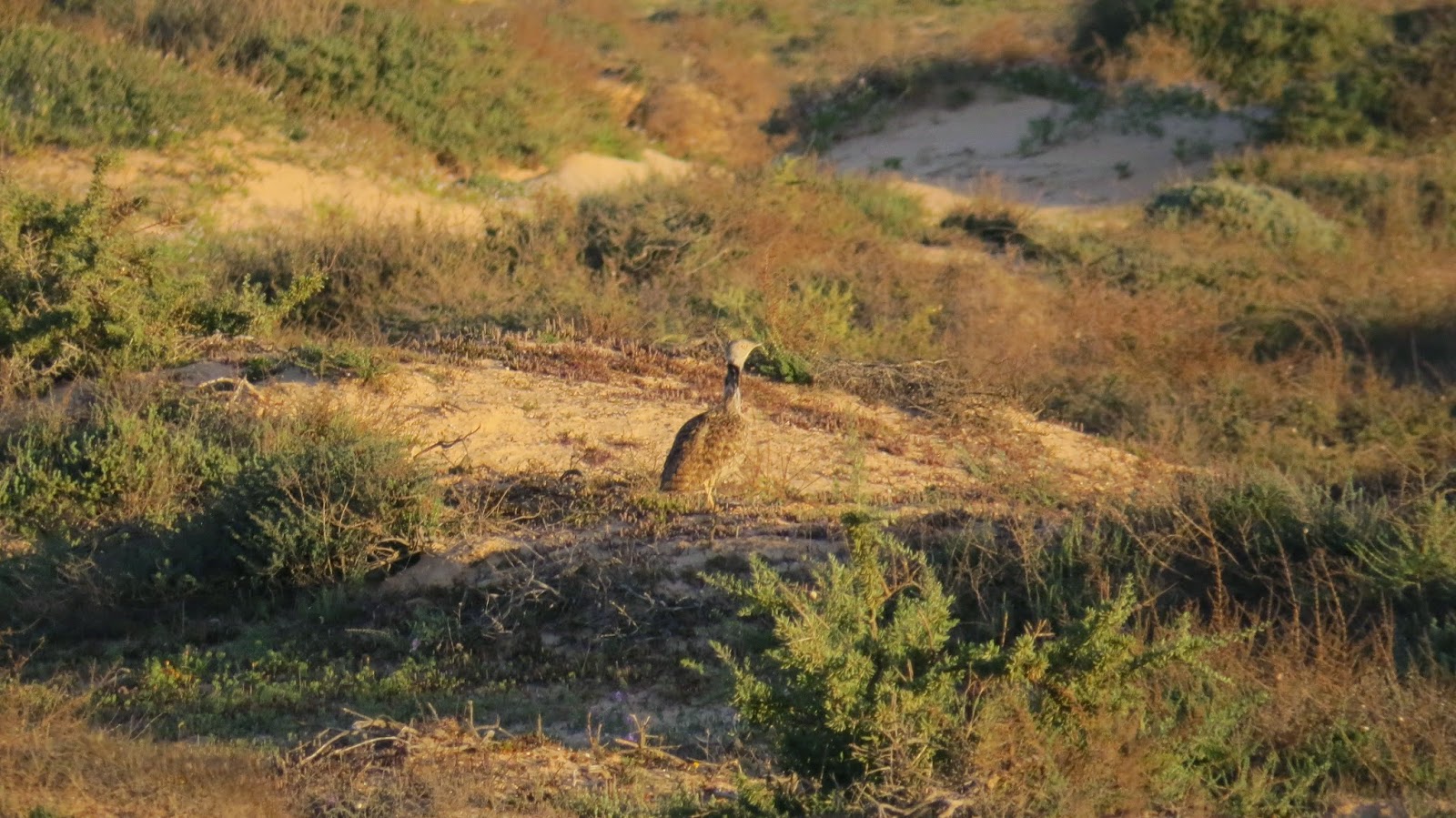Fuerteventura - Day Two
What a slog. Whoever said you can just turn up to a place, see everything and leave is fundamentally misguided. A dawn start, a dusk finish, lots of driving, and lots of walking. Lots of beautiful scenery too particularly on the west side of the island from El Cotillo south towards La Pared.
Not knowing the specifics of finding my target species, I essentially searched suitable habitat and got one reasonably early. And what a belter. One of many excursions onto the rocky/sandy tracks, opportunistically sensed that something may be lurking within an area of dunes that were fragmented by clumps of vegetation. A large bird disappeared behind a tussock. Concentrating on the spot, a HOUBARA BUSTARD appeared, neck low, ponderously navigating the sandy tracks. It disappeared again. There were small trees for which to hide behind. Out again and better views until it hopped up onto one of the sandy mounds, extending its neck and posing modestly in the morning sun.
Not knowing the specifics of finding my target species, I essentially searched suitable habitat and got one reasonably early. And what a belter. One of many excursions onto the rocky/sandy tracks, opportunistically sensed that something may be lurking within an area of dunes that were fragmented by clumps of vegetation. A large bird disappeared behind a tussock. Concentrating on the spot, a HOUBARA BUSTARD appeared, neck low, ponderously navigating the sandy tracks. It disappeared again. There were small trees for which to hide behind. Out again and better views until it hopped up onto one of the sandy mounds, extending its neck and posing modestly in the morning sun.
The bird eventually disappeared and turned out to be the only one I saw on the trip. They are very elusive - I appreciate others have had more prolonged views, but I was thrilled with mine.
Another of my main targets is a gem of sandy/desert landscapes. The track from La Oliva to Tindaya is said to be a traditional location. Some of the tracks are particularly rocky in places, I apologised prefusely to my hire car, The full insurance purchased in advance gave me peace of mind.
I searched the area - I searched till my eyes bled. There was a lot of land to look at, gratifying landscapes, in a barren environment. The silence deafened but for the soothing melodies of territorial Larks and Pipits.
Lesser Short-Toed Lark
Following tracks and scanning, I picked up a male Spectacled Warbler on its breeding ground, Hoopoe flew around in pairs, Southern Grey Shrikes sat on wires, and a distant Barbary Squirrel dashed between the rocks.
Southern Koenigi Grey Shrike
Travelling south, I headed to Embalse de Los Molinos, a reservoir that attracted at least 60 RUDDY SHELDUCK boisterous and gregarious in their behaviour, they were constantly on the move flying up and down the water course. Also there were two Black-Winged Stilt, single Greenshank, three Little Ringed Plover, and a Common Sandpiper. At the entrance to the reserve, two TRUMPETER FINCH landed in front of me, the prominent red bill and the distinctive call giving it away.
Ruddy Shelduck
The endemic was the big draw. Scanning away from the reservoir and down a ravine there was plenty of avian activity. Sliding my way down the rocky facade past the dam, CANARY ISLAND STONECHAT were present, at least three active males and a vocal female. A lovely little bird, looking more like Whinchat at first, particularity in posture. A prominent pale supercilium, the clean white collar, and the ochre-tinged neck. Pure joy.
I spent a bit of time with the these charming birds, watching them fly between the rocks, actively calling. Full of character.
On the move again and down to Vega de Rio Palmas. It took a little bit of time to pin down the AFRICAN BLUE TIT. They were present maybe six in number, and recognised initially by the familiar call of the Blue Tit, with a slightly different flourish and tone. To see them, well, they are gaudy. Much darker than the race that we are familiar with, as if ours have been faded out my far too many machine washes. An adult was observed feeding young just off the main road in the centre of the village. Also there was my first ever Monarch butterfly. A Chiffchaff (Canary Islands Chiffy?), and a male Blackcap in sub-song.
No time to linger. Heading further south. The challenge was still there. A concentrated search in the semi-desert of La Pared didn't yield what I had hoped for, but two bubbling Black-Bellied Sandgrouse flying directly over my head illuminated by the last hour of sunlight was a real bonus - stunning birds these. I hadn't expected that right here.
Time was up. Enough searching and with the sun about to set, it was time to head back.













Comments
Post a Comment